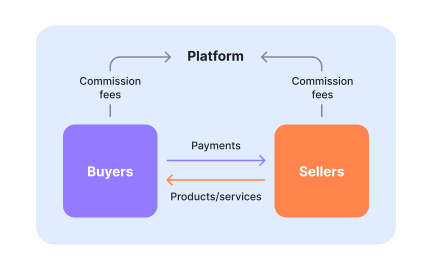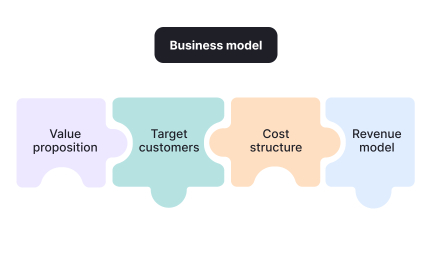Product Operating Model
A product operating model defines how a company structures roles, tools, and processes to plan, build, and ship digital products at scale.
What is Product Operating Model?
Your product organization feels chaotic because teams operate with different processes, tools, and definitions of success, leading to inconsistent delivery, confused stakeholders, and products that don't work together despite being from the same company.
Most companies let product practices evolve organically without designing how product development should work systematically, missing that a Product Operating Model can align teams while maintaining agility through shared principles rather than rigid rules.
A Product Operating Model is the systematic design of how product organizations work, including team structures, decision rights, processes, tools, and success metrics that enable consistent excellence while adapting to different contexts.
Organizations with well-designed Product Operating Models achieve 55% better product outcomes, deliver 40% more consistently, and scale significantly more effectively because teams operate from shared foundations rather than reinventing approaches.
Think about how Spotify's model of Squads, Tribes, Chapters, and Guilds creates consistency with autonomy, or how Amazon's Working Backwards process ensures consistent innovation approaches across thousands of teams.
Why Product Operating Models Matter for Scale
Your product organization struggles to scale because what worked for 10 people breaks at 100, and different teams solving similar problems differently wastes effort while confusing customers with inconsistent experiences across products.
The cost of lacking operating models compounds through every duplicated effort and inconsistent delivery. You waste time reinventing processes, create conflicting products, frustrate customers with inconsistency, and limit growth when scaling requires reorganizing everything rather than following proven patterns.
What effective Product Operating Models deliver:
Better scalability through systematic design because operating models enable growth without chaos rather than hoping good practices spread organically.
When organizations implement operating models properly, new teams become productive quickly rather than figuring everything out from scratch.
Enhanced consistency with maintained agility through shared principles and tools that create coherence without stifling innovation or context-appropriate adaptation.
Improved efficiency and reduced waste because teams leverage common approaches rather than solving identical problems differently across the organization.
Stronger talent development and mobility as common operating models enable people to move between teams rather than starting over completely.
Clearer accountability and decision-making through defined roles and rights rather than political negotiations for every decision.
Advanced Product Operating Models
Once you've implemented basic operating models, optimize for your specific context.
Adaptive Operating Models: Design models that evolve with growth stages rather than static structures, planning transformations rather than permanent solutions.
Global Operating Harmonization: Balance global consistency with local adaptation rather than forcing uniform models, respecting cultural and market differences.
Digital-Physical Product Integration: Create operating models spanning digital and physical products rather than separate approaches, recognizing convergence reality.
Ecosystem Operating Models: Extend models beyond company boundaries rather than internal focus, including partners in operating design.
Step 1: Assess Current Operating Reality (Month 1)
Map how product development actually works today across different teams rather than theoretical processes, identifying patterns and inconsistencies without judgment.
This creates operating model foundation based on organizational reality rather than ivory tower designs disconnected from how work happens.
Step 2: Define Core Operating Principles (Month 1-2)
Establish non-negotiable principles that guide all product work rather than prescriptive rules, creating consistency through shared values rather than rigid compliance.
Focus principles on outcomes rather than methods, allowing teams to adapt implementation while maintaining strategic alignment.
Step 3: Design Team Structures and Interactions (Month 2-3)
Create clear team types, reporting structures, and collaboration models rather than ad-hoc organization, enabling scale without bureaucracy.
Balance autonomy with alignment to ensure teams can move fast while building coherent product portfolios rather than disconnected features.
Step 4: Standardize Key Processes and Tools (Month 3-4)
Select common approaches for critical processes like planning and launches rather than allowing infinite variation, reducing complexity while maintaining flexibility.
Step 5: Implement Gradually with Feedback Loops (Month 4-6)
Roll out operating model incrementally rather than big-bang change, learning and adapting based on what works in your specific context.
This ensures Product Operating Models enhance rather than constrain product excellence through thoughtful systematic design.
If operating models don't improve outcomes, examine whether they enable teams rather than constraining them with bureaucracy.
The Problem: Operating models that become rigid bureaucracy, stifling innovation in pursuit of consistency and control.
The Fix: Focus on principles over processes rather than detailed prescriptions, enabling consistency through shared values not rules.
The Problem: Copy-paste adoption of other companies' models without adaptation, like implementing "Spotify Model" without Spotify's culture.
The Fix: Design for your context rather than copying others, taking inspiration while creating models fitting your unique situation.
The Problem: Operating models that optimize for reporting rather than value delivery, creating neat org charts that don't improve products.
The Fix: Design from customer value backwards rather than organizational convenience, ensuring models serve product excellence not administrative tidiness.
Create Product Operating Models that enable excellence at scale rather than bureaucracy disguised as organization design.
Recommended resources
Courses

UX Research

HTML Foundations








